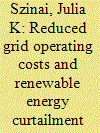| Srl | Item |
| 1 |
ID:
162918


|
|
|
|
|
| Summary/Abstract |
Electricity grid resilience in the face of unending hazards plays a crucial role in energy security of a nation. Based on hazard impact variability across different regions of Nigeria, formulating and implementing a contextualized environmental hazard mitigation policy to reduce grid vulnerability to the multiple effects of hazards and disasters is a strategic imperative that can result to longevity of grid networks, with increased probability of critical success factors such as safety, reliability of electricity supply and electricity access in the Sudan Sahel region of Nigeria. Policies outlined in the Nigeria's National Disaster Management Framework (NDMF) and the scope of its National Disaster Response Plan (NDRP) takes no cognizance of the peculiar environmental hazards and disasters that impinges on sustainability of electricity grid infrastructures, and the mitigation strategies to reduce their risks, with reference to the Sudan Sahel region. This paper provides insight on the Sahelian hazards, overview shortcomings of the NDMF and NDRP, and advocates for the contextualization of hazard mitigation policy for electricity grids in the Sudan Sahel based on international best practices and findings of field surveys of the Zamfara Sahel.
|
|
|
|
|
|
|
|
|
|
|
|
|
|
|
|
| 2 |
ID:
115670


|
|
|
|
|
| Publication |
2012.
|
| Summary/Abstract |
There is an increasing impetus to transform the U.S transportation sector and transition away from the uncertainties of oil supply. One of the most viable current solutions is the adoption of electric vehicles (EVs). These vehicles allow for a transportation system that would be flexible in its fuel demands. However, utilities may need to address questions such as distribution constraints, electricity tariffs and incentives and public charging locations before large scale electric vehicle adoption can be realized. In this study, the effect of electric vehicles on households in Indianapolis is examined. A four-step traffic flow model is used to characterize the usage characteristics of vehicles in the Indianapolis metropolitan area. This data is then used to simulate EV usage patterns which can be used to determine household electricity usage characteristics. These results are differentiated by the zones with which the households are associated. Economic costs are then calculated for the individual households. Finally, possible public charging locations are examined.
|
|
|
|
|
|
|
|
|
|
|
|
|
|
|
|
| 3 |
ID:
124244


|
|
|
|
|
| Publication |
2013.
|
| Summary/Abstract |
This article analyzes the thermal energy options available in the country to support the expansion of Brazil's electricity grid capacity. The country's electricity mix consists primarily of renewable sources of energy and this configuration will be maintained throughout the 21st century. However, grid expansion can no longer benefit from hydroelectric power plants with large reservoirs leading to a greater participation of thermal power plants. Among the thermal sources available in the country, nuclear power has important comparative advantages. Recognizing these benefits, the Brazilian government has established that expanding electricity grid capacity will amount to up to 8000 MW through nuclear energy by 2030.
The use of nuclear technology for electricity generation has historically been a controversial issue worldwide and some countries have decided to review their nuclear programs in the aftermath of the 2011 Fukushima nuclear accident.
This article shows that increasing the participation of nuclear energy in Brazil's electricity grid will provide important benefits for the country by ensuring energy security, keeping Brazil's electricity mix as one of the cleanest in the world, securing electricity grid reliability and safety and reducing operating costs.
|
|
|
|
|
|
|
|
|
|
|
|
|
|
|
|
| 4 |
ID:
125499


|
|
|
|
|
| Publication |
2013.
|
| Summary/Abstract |
This article presents a quantitative assessment of the need for electricity transmission capacity investments in Germany for 2030. Congestion is analyzed and its possible relief through appropriate grid reinforcements as those described in the Ten Year Network Development Plan (TYNDP) of the European Commission. Congestion is investigated in three scenarios which differ in the location of power resources and the line expansion projects accomplished. Results show that the TYNDP and overlay line projects proposed in 2011 are not sufficient measures to cope with the increasing demand for transmission capacity. The paper also concludes that if power generation resources are moved closer to demand centers grid bottlenecks can be partly relieved by 2030. The introduction of a high-voltage direct current (HVDC) backbone grid does not relieve congestion significantly.
|
|
|
|
|
|
|
|
|
|
|
|
|
|
|
|
| 5 |
ID:
169845


|
|
|
|
|
| Summary/Abstract |
Widespread adoption of plug-in electric vehicles (PEVs) and renewable energy (RE) can help to jointly decarbonize the transportation and electricity sectors. Previous studies indicate strategies to manage PEV charging facilitate integration of RE into electricity grids, but the value of such strategies at scale is unclear because electricity markets and PEV charging have been inadequately represented together. This analysis focuses on the state of California in 2025, and improves on prior work by linking high-resolution mobility and grid dispatch models to quantify the value of managed charging under a 50% RE grid and PEV adoption scenarios up to California's 5 million vehicle target. Even after accounting for practical charging and grid constraints, 0.95 to 5 million “smart” charging PEVs avoid $120 to $690 million in California grid operating costs annually (up to 10% of total costs) and reduce RE curtailment up to 40% relative to unmanaged PEVs. Overnight time-of-use (TOU) charging provides similar cost savings but increases curtailment. Both of these managed strategies defer system infrastructure expansion at the 5 million PEV deployment. The results suggest residential smart charging complemented by TOU tariffs with added daytime periods are policies with most potential to advance California's dual PEV and RE goals.
|
|
|
|
|
|
|
|
|
|
|
|
|
|
|
|